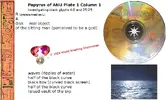I dont agree with the images that were pulled out to fit the monitor
From the quick mention on the video it does not seem apparent, but in context it becomes obvious.
The context is the two sets of black glyphs:
(1) The LA-disk (real object) of the sitting man [computer operator]; and
(2) The black box (curved black screen area) [by different orientation, not the base box] half of the black curve [is the] waves (ripples of water) half of the black curve [is the] raised vault of the sky.
.
Explanation
In ancient times an English 'L' was pronounced as an 'R', similar to how some Asians pronounce licorice as ricorice. So when 'LA' was said, they pronounced it as 'RA' and wrote it up as 'RA'.
Ronald Pegg had already identified the 1995 Ancient Civilizations of the Mediterranean cd-rom (pictured) made by the sca-LA company [literally the (sca)LA-disk] as being documented and described in over 25 other ancient texts before I came to investigate the Papyrus of Ani.
Thus is was prudent to use it as a test disk.
When testing it, a main screen seen where the monitor was originally black - is one of half waves and half sky (pictured).
This is what the scribe ani has depicted and documented.
.
In context, Ani is literally reporting the picture seen on the curved black screen of the monitor from the sitting man's (sca)LA-disk.

